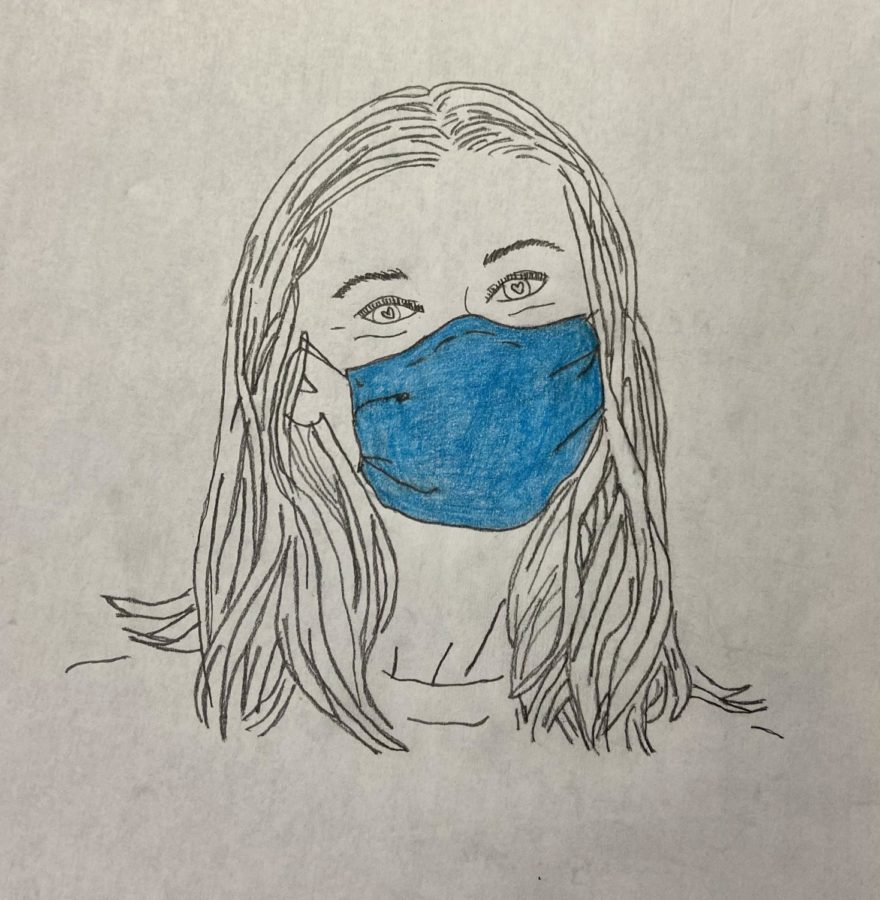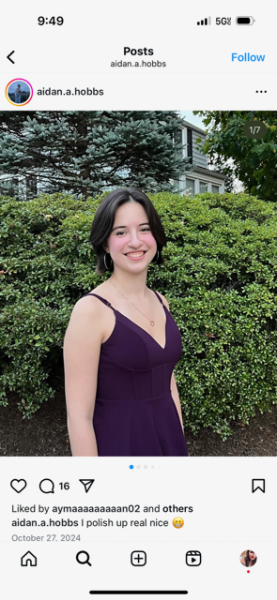Lift on mask mandates
Students share their thoughts on the lift of the mask mandates in VA
Girl wearing a face mask
Under the new Centers for Disease Control and Prevention (CDC) guidelines, the CDC has changed how it measures the severity of the novel coronavirus at the local level and relaxed its masking guidelines. The CDC advises that people wear a mask only when COVID-19 related hospitalization rates are high. This changed from measuring based on cases to based on hospitalizations. We have entered into a new phase of the Pandemic. Although, COVID-19 is still circulating around, we have effective vaccines, tests, and treatments accessible to us.
When the local hospitalization rate is low or moderate, people are given the option to forego masks. Americans live in communities where wearing masks is no longer required under the new CDC guidelines, since hospitalization rates are low. Layered prevention strategies—staying up to date on vaccines and wearing masks—can help prevent severe illness and reduce the potential strain on the healthcare system. The CDC advises wearing a mask with the best fit, protection, and comfort for you and your family.
It should be noted, the Arlington School Board is suing to overturn Governor Glenn Youngkin’s state-wide executive order, which prohibits school districts from requiring students to wear masks. School districts, including Arlington Public Schools (APS), have already decided to pursue maintaining a mask requirement while establishing in-person instruction. APS has also decided to update its masking policy based on the CDC guidance. This decision came out just a day after Governor Youngkin signed a bill that made masks optional in Virginia schools.
In a school board meeting, APS decided that it will require students and staff to wear masks until March 1, the deadline for schools to comply with the new state law. After March 1, parents have the option to be able to decide whether their children will wear masks in school or not. The school still recommends that staff and students be regularly tested for the coronavirus every week.
Senior Alexander Breckinridge Tart described his initial reaction upon hearing the news about the lift of the mask mandate.
“I was [expecting more people] to get [angry] at it,” Tart said. “In schools, I was expecting that to be one of the first places because parents get riled up about school-related things. I thought there was [going] to be more of a backlash from Arlington County.”
Senior Aastha Nepali knows about this mandate to a great extent since she has been keeping up with Youngkin’s policy. Upon hearing the news of the lifting of the mask mandate, her reaction was quite similar to that of others.
“I thought it was kind of rash [because] I don’t think that he did it based on the CDC recommendation, but rather [that] was one of his core points he was [trying] to make during the elections,” Nepali said.
Her argument explores the more political side of what Youngkin was trying to accomplish through this mandate. Youngkin, like many Republicans, repeatedly pledged to give parents more say in pandemic-related decision-making during his campaign. His victory allowed the Republican Party to pass legislation on issues such as education and parental rights. That focus, however, expanded beyond books in schools to include concerns about how COVID-19 and COVID-19 are addressed in classrooms. The debate over how much control parents should have over daily school decisions, specifically concerning masks, has a good chance to remain a political issue for years.
Nepali also commented on the aspects of why wearing a mask is beneficial to the health system. When you’re sick, wearing a mask can help prevent your germs from infecting others. If you’re healthy, a mask can help keep sick people’s respiratory droplets from getting into your nose and mouth. Usually, masks are most effective when everyone is wearing them.
“You don’t know someone’s health background [that] they could be at severe risk. Everyone should just have it on for the greater good and taking it off… you could put anyone at risk,” Nepali said.
Whether or not there is a pandemic, immunocompromised patients often wear masks. They are at a higher risk of suffering severe outcomes if they were to become ill.
Senior Isabela Rodriguez has also expressed her opinion on why she thinks that students and staff should be keeping their masks on during school hours.
“I just think it’s the bare minimum, it’s not that hard,” Rodriguez said. “[If] it can prevent anyone from getting COVID [even] the smallest chance, so why not? [It’s] so easy.”
She feels that the school is lacking in terms of protecting its students against the transmission of the coronavirus pandemic as the number of cases tends to still be relatively high.
“I just don’t like the [idea of a lifting of the mask mandate]… I think it is a terrible idea,” Rodriguez said.
Tart has an opposing view on how the school is handling the transmission of coronavirus amongst students and staff. He believes that the school has been doing a pretty good job in terms of handling student-student interactions in classrooms.
‘’All the desks are separated, so people are already somewhat far from each other, and [during] lunch, everybody has their masks off,” Tart said. “It helps in classes to have your mask on, but I think there are a lot of situations in the school where people already have their masks off.”
Tart feels that COVID-19 can’t be avoided and it is difficult to implement a mask mandate that every single student is willing to follow.
“It’s been working since there [is no] huge absences of students and [staff throughout the school year],” Tart said.
Nepali agrees that the school was doing a relatively good job of handling the COVID-19 pandemic during the 2020-2021 school year. She mentions how classes now barely have any wipes to wipe down the desks, hand sanitizers, or even tissues. One of the ways Nepali hopes the school will counteract COVID-19 is by doing a better job at contact tracing by informing classmates if they had been in contact with an infected individual.
“I don’t think that the school [really tries contact tracing anymore] because if someone gets [COVID], it’s kind of [just brushed off],” Nepali said. “Doing a better job [overall] of confining the person who got COVID would help a lot.”
She mentions how the school does not release specific information on the students’ name and class period that has contacted COVID-19 and this leads to a lot of rumors being spread throughout the student body. Identification and quarantine of close contacts play an important role in reducing the spread of COVID-19. Nepali suggests that schools should gather and review the participants’ activities at the school during the time that they were infectious to identify close contacts.
“There’s just sort of social implications behind wearing [a] mask [and] that’s just an inevitable complicated situation that we’re in [right now],” Tart said.
What did you think about this story? Do you have any suggestions for improvements or other articles that you would like to see? Please use the contact form to communicate with us! (Keep all information school-appropriate)
https://docs.google.com/forms/d/e/1FAIpQLSeRYRWwLLzvs2rqwHSGdr-DQRvxhUSx9UcaXypXxnvVuCqwyA/viewform










